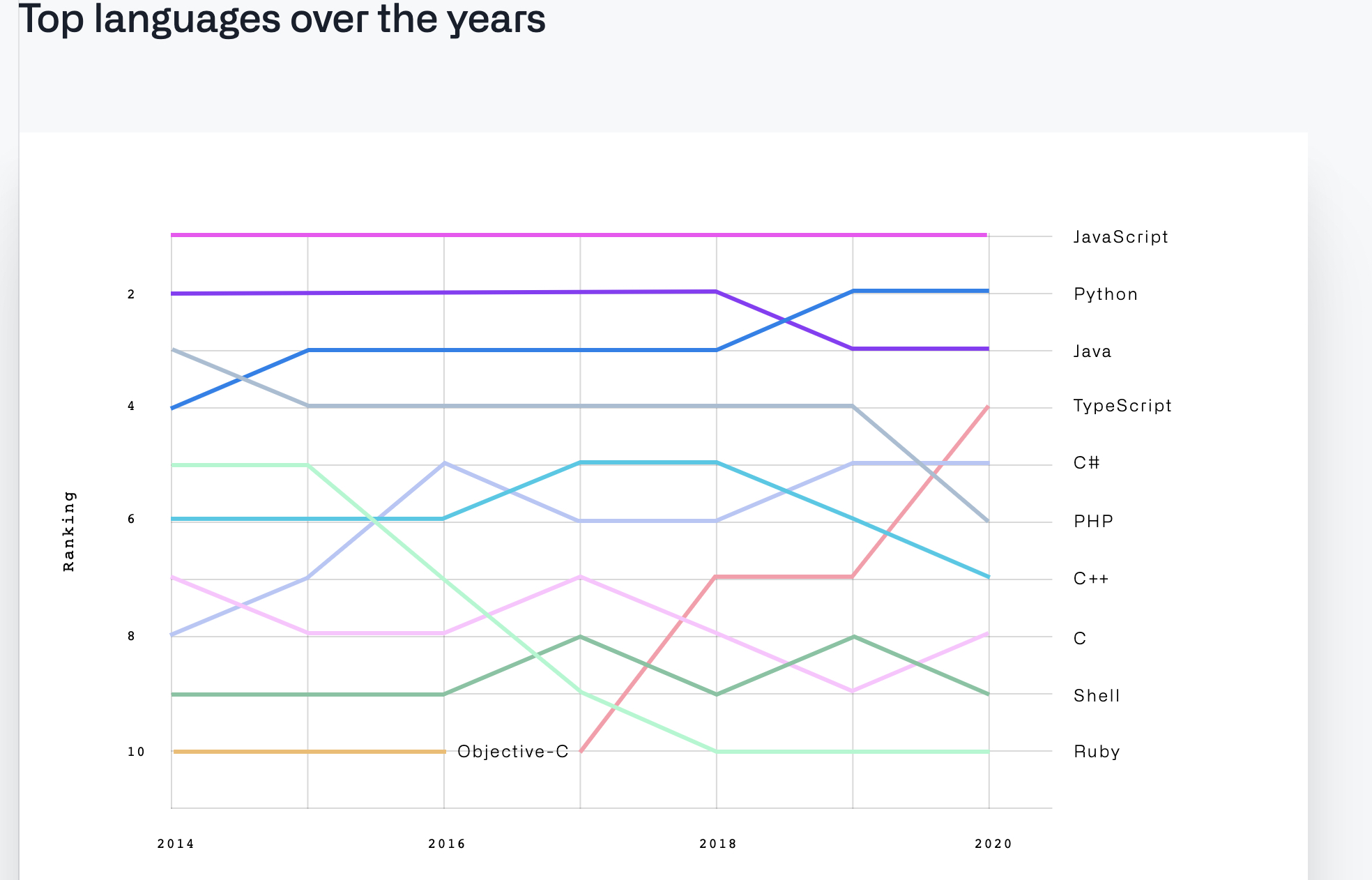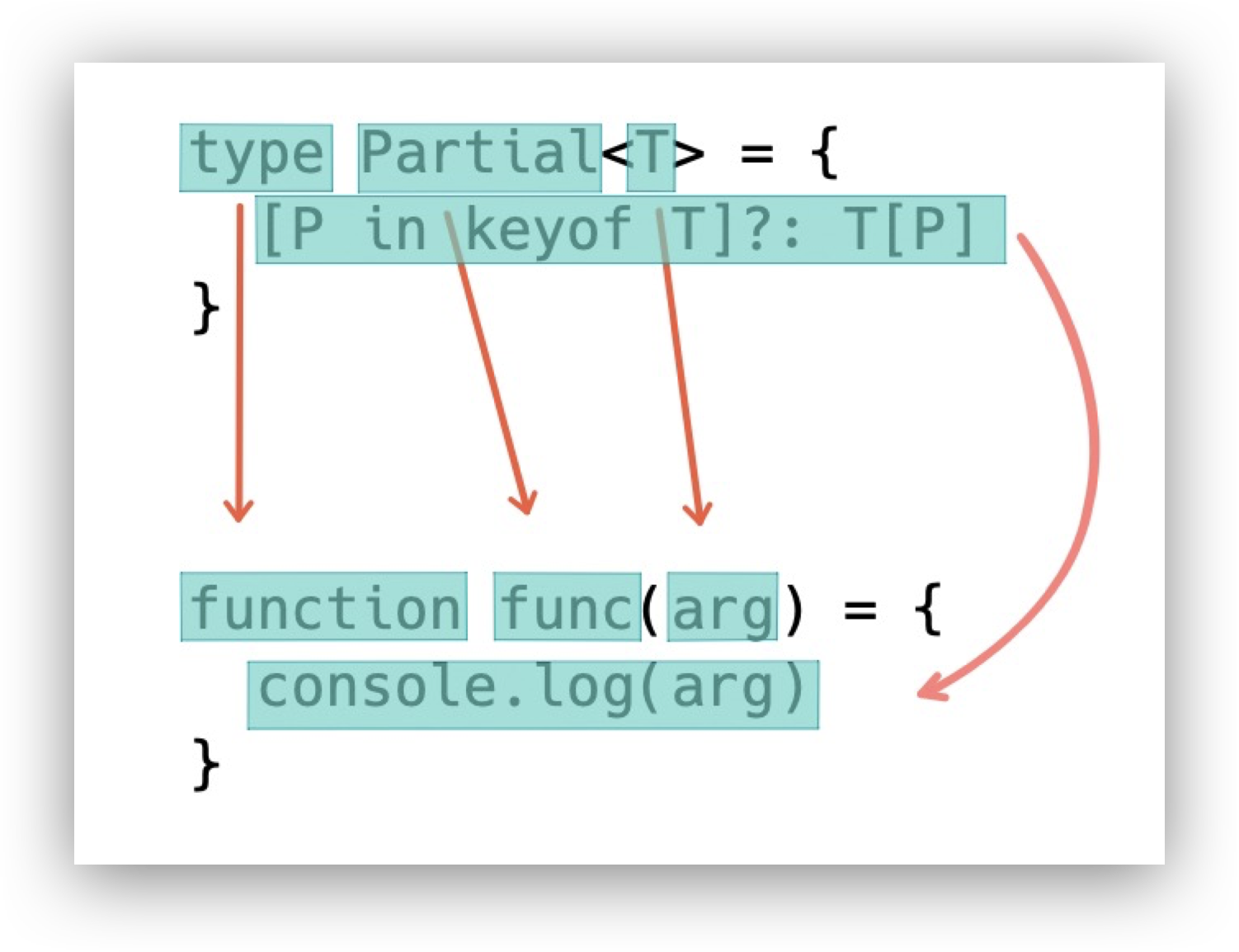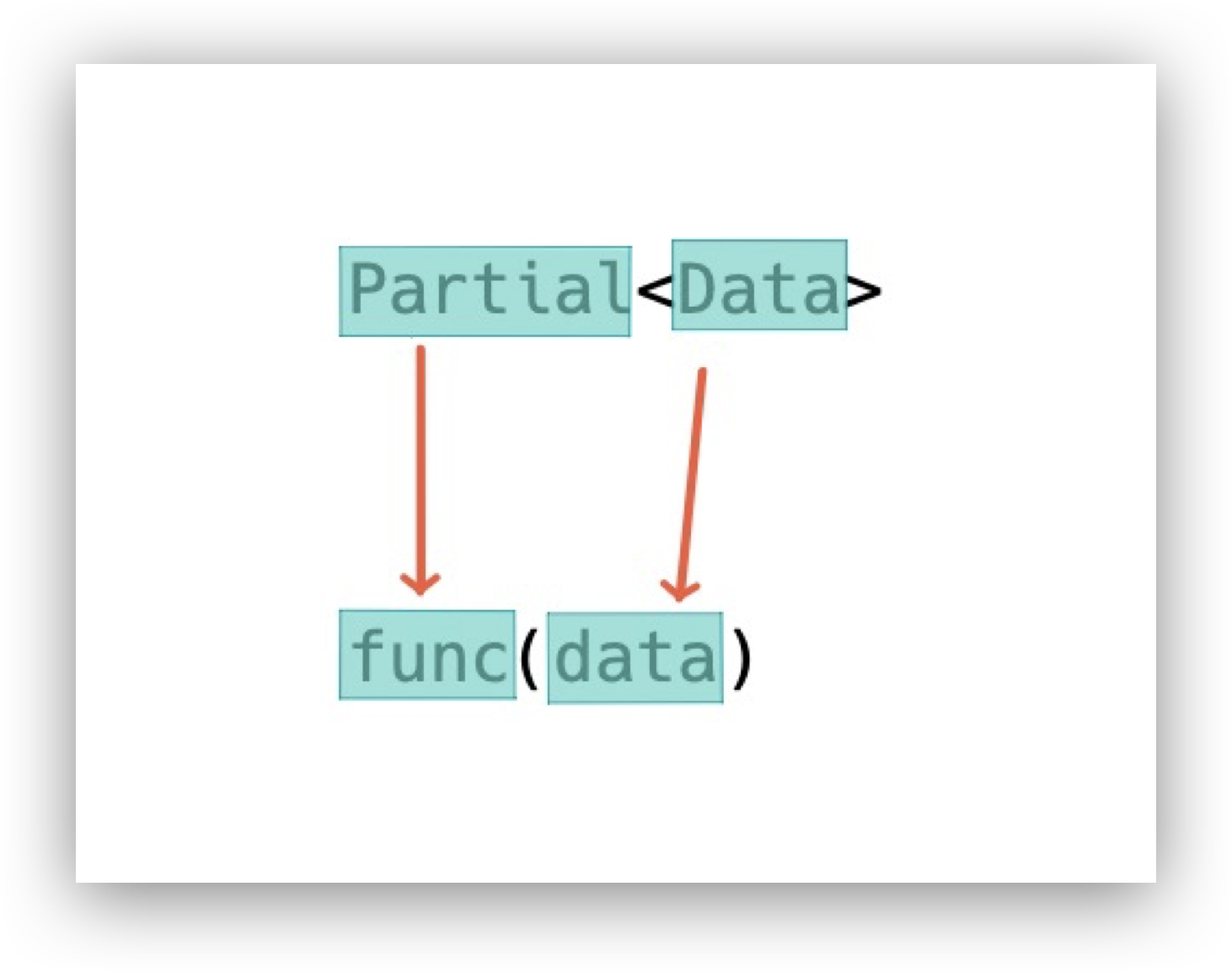TypeScript 那些事
date
Jan 7, 2021
slug
typescript-things
status
Published
tags
TypeScript
summary
近年来,TypeScript在前端社区中的发展迅速,越来越多的开源项目投身TypeScript中,不管项目中是否使用TypeScript,了解TypeScript已经是前端必会的技能点了。作为长期习惯了动态类型语言的前端开发者,初上手TypeScript或多或少都会遇到一些问题
type
Post
前言TS是什么为什么用令人困扰的使用现状type or interface基本类型voidneverunknown如何声明对象?索引类型额外属性检查(excess property check)类型兼容性可赋值性 assignable子类型函数子类型泛型为什么需要泛型和函数相似泛型类型泛型函数泛型接口泛型类类型编程相关操作符extendsinfer(有条件类型中的类型推断)as const迭代复合类型复合类型间的转换一个类型编程的例子类型保护typeofinstanceofin字面量类型保护自定义类型保护的类型谓词流动的类型一个改进的例子一点点建议一点技巧借助interface自动合并扩展npm库声明! 非空断言操作符?. 可选链运算符?? 空值合并运算符Refs
前言

近年来,TypeScript在前端社区中的发展迅速,越来越多的开源项目投身TypeScript中,不管项目中是否使用TypeScript,了解TypeScript已经是前端必会的技能点了。作为长期习惯了动态类型语言的前端开发者,初上手TypeScript或多或少都会遇到一些问题
本文不会从所有基础讲解TS相关概念(最好你已经有一些TS的基础知识,官方文档),主要探讨一些在平时实践中可能遇到的问题和一些高级用法
TS是什么
- JavaScript的超集
- 编译期行为
- 不引入额外开销,不改变运行时行为
- 始终与 ECMAScript 语言标准一致 (stage 3语法)
TypeScript = Type + (ECMA)Script ,在TS语言早期有一些扩展运行时代码语义的语法(如:enum、namespace等)这些都未被标准ECMAScript语法所支持,与使用TypeScript 不侵入运行时的宗旨不符,一般不建议使用
为什么用
- 可维护性(良好的标注和类型,几乎相当于文档,增加了代码维护性)
- 确保运行时质量,减少代码错误(编译或编辑时及时的代码提示减少写出错误代码的概率)
- 提升开发效率
提升开发效率,可能很多人会有不同的意见,觉得写了TS反而是负担。但实际没有TS时,假如别人写了非常复杂的通用组件,缺乏文档的情况下,你需要对照代码查看所需传入的属性(props)和类型,组件修改了属性,往往需要运行时才能发现报错,都会降低开发效率增加开发负担
令人困扰的使用现状
在项目中开始使用TypeScript很简单,可是越来越多的人开始抱怨使用的各种问题
- 代码代码提示并不智能,似乎只能显式的定义类型,才能有代码提示。
- 各种各样的类型报错苦不堪言,本以为听信网上说
TypeScript可以提高代码可维护性,结果却发现徒增了不少开发负担。
- 显式地定义所有的类型似乎能应付大部分常见,但遇到有些复杂的情况却发现无能为力,只能含恨写下若干的
as any默默等待代码review时的公开处刑
接下来我们从基础类型开始了解TypeScript
type or interface
初上手时,最令人困惑的是,
type和interface,二者功能相近具体什么时候用
interface呢,什么时候用type呢相同点:
- 都可以描述一个对象或者函数
interface User {
name: string
age: number
}
interface SetUser {
(name: string, age: number): void;
}
type User = {
name: string
age: number
};
type SetUser = (name: string, age: number) => void;- 拓展(extends)与交叉类型(Intersection Types)
interface 可以 extends, 但 type 是不允许 extends 和 implement 的,但是 type却可以通过交叉类型 实现 interface 的 extend 行为,并且两者并不是相互独立的,也就是说 interface 可以 extends type, type 也可以 与 interface 类型 交叉
// interface extends type
type Name = {
name: string;
}
interface User extends Name {
age: number;
}
// type & interface
interface Name {
name: string;
}
type User = Name & {
age: number;
}不同点:
- type 可以而 interface 不行
- type 可以声明基本类型别名,联合类型,元组等类型
// 基本类型别名
type Name = string
// 联合类型
interface Dog {
wong();
}
interface Cat {
miao();
}
type Pet = Dog | Cat
// 具体定义数组每个位置的类型(元祖)
type PetList = [Dog, Pet]type Tuple = [number, string];
const a: Tuple = [2, 'sir'];
type Size = 'small' | 'default' | 'big' | number;
const b: Size = 24;- interface可以而type不行
- 自动聚合
interface User {
name: string
age: number
}
interface User {
sex: string
}
/*
User 接口为 {
name: string
age: number
sex: string
}
*/// 这里不对
// interface FuncWithAttachment {
// (param: string): boolean;
// someProperty: number;
// }
// const testFunc: FuncWithAttachment = ...;
// // 有类型提醒
// const result = testFunc('mike');
// // 有类型提醒
// testFunc.someProperty = 3;怎么用:
从语义上来说,type为类型别名,并不会实际产生新的类型
官方推荐能用interface实现尽量用interface实现,在interface无法实现时,再考虑type
基本类型
number、boolean、string、function、array、tuple、enum、
null、undefined、any、void、never、object、
字面量(true,false,1,2,‘a’)等
这里主要探讨几个TS中特殊的类型
void
跟any有点相反,不代表任何类型,只有null和undefined可以赋值给它们
never
- 表示绝对不会发生的类型,any也不能赋值给它
- never 是 | 运算的幺元(单位元),即 x | never = x。这个特性在类型编程中有很好的运用方式,比如
Exclude<Result, string>,作用是从类型T中剔除U中的属性。涉及了一些泛型和关键字,后文也会讲到,大致理解思路就是,通过将不需要属性先变为never再取联合类型就只剩下需要的了
type Exclude<T, U> = T extends U ? never : T;- 一个never应用的例子:来源
通过
never来确保 handleValue 函数的switch把所有类型变量都遍历了interface Foo {
type: 'foo'
}
interface Bar {
type: 'bar'
}
type All = Foo | Bar
function handleValue(val: All) {
switch (val.type) {
case 'foo':
// 这里 val 被收窄为 Foo
break
case 'bar':
// val 在这里是 Bar
break
default:
// val 在这里是 never
const exhaustiveCheck: never = val
break
}
}unknown
unknown字面理解和any很像,任何类型都可赋值给它,但有一点,unknown类型不能赋值给除了unknown或any的其他任何类型,使用前必需显式进行指定类型,或是在有条件判断情况下能够隐式地进行类型推断的情况。
- 交叉类型(
&)不起作用,联合类型(|)起绝对作用,跟never正好相反
unknown用于变量类型不确定,但肯定可以确定的情形下,比如下面这个示例中,入参总归会有个值,根据这个值的类型进行不同的处理,这里使用unknown替代any则会更加类型安全
function prettyPrint(x: unknown): string {
if (Array.isArray(x)) {
return "[" + x.map(prettyPrint).join(", ") + "]"
}
if (typeof x === "string") {
return `"${x}"`
}
if (typeof x === "number") {
return String(x)
}
return "etc."
}如何声明对象?
声明一个确定属性的对象或许是容易的,使用type/interface即可,如果声明一个不确定的对象呢?
我们可能会这么写:
const iNeedObject1 = (a: object) => {
console.log(a)
}
const iNeedObject2 = (a: Object) => {
console.log(a)
}
const iNeedObject3 = (a: {}) => {
console.log(a)
}实际调用我们发现除了第一个正确校验了非对象参数,其他居然都通过了,这结果似乎和我们预期的结果不太一样,那我们好好看看这几个基础类型有什么不同
iNeedObject1('1') // 😄 正确提示了错误: Argument of type 'string' is not assignable to parameter of type 'object'.(2345)
iNeedObject2('1') // 🤔 未报错
iNeedObject3('1') // 🤔 未报错object
- obejct是一个代表非原生类型的类型,即任何不是number、string、boolean、bigint、symbol、null或undefined的类型
- 可以使用在 Object 类型上定义的所有属性和方法,这些属性和方法可通过 JavaScript 的原型链隐式地使用,但是不会有编辑器的提示
const iNeedObject = (a: object) => {
console.log(a)
}
iNeedObject({a:1}) // OK
iNeedObject('a') // 报错:类型“string”的参数不能赋给类型“object”的参数Object
- 类型是所有
Object类的实例的类型
- 在TS中通过接口定义了Object.prototype 原型对象上的属性,因此你调用原型上的方法你会获得编辑器的提示
- Object 包括原始值,我们知道JS引擎中会自动隐式进行装箱和拆箱,这样我们在基本类型中也能调用属性和方法,因此也会包含Object类型中所定义的结构,装箱之后的类型自然也是属于Object类型
- 使用Object声明的对象,与原型属性类型不能冲突
空对象类型{}
- 它描述了一个没有成员的对象。当你试图访问这样一个对象的任意属性时,TypeScript 会产生一个编译时错误
- 仍然可以使用在 Object 类型上定义的所有属性和方法,这些属性和方法可通过 JavaScript 的原型链隐式地使用
- 同样包括原始值
上面三种声明对象的方式都无法访问对象的属性,如果我们需要声明一个包含任意属性的对象呢?比如下面这个例子
function filterEmptyValue (obj: object) {
let filteredObj = { ...obj }
Object.keys(filteredObj).forEach((key: string) => {
// ❌ 类型为 "string" 的表达式不能用于索引类型 "{}"
if (filteredObj[key] === '') {
delete filteredObj[key]
}
})
return filteredObj
}索引类型
解决上面的问题,答案就是使用索引类型
// 可索引的类型
interface LooseObj {
[key: string]: any
}Typescript支持两种索引签名:字符串和数字。 可以同时使用两种类型的索引,但是数字索引的返回值必须是字符串索引返回值类型的子类型。 这是因为当使用 number 来索引时,JavaScript会将它转换成 string 然后再去索引对象额外属性检查(excess property check)
首先看一个例子
interface Type1Item {
a: number;
}
interface Type2Item {
a: number;
b: number;
}
let vtype1: Type1Item = {a: 1}
let vtype2: Type2Item = {a: 1, b: 2}
vtype1 = {a: 1, b: 2} // 报错,不能将类型“{ a: number; b: number; }”分配给类型“Type1Item”。对象文字可以只指定已知属性,并且“b”不在类型“Type1Item”中。
vtype1 = vtype2 // OK 我们发现直接字面量赋值的方式会报错,通过变量二次传递赋值却可以。这是两个问题,我们分开来看
- 为什么
vtype1 = vtype2可以赋值?因为Type2Item是Type1Item的子类型(后文会讲到满足什么条件属于子类型),所以可以把Type2Item类型的值赋值给Type1Item
- 为什么直接字面量赋值的方式会报错?因为TypeScript内对于对象的赋值会进行
额外属性检查(excess property check),会报错,tsconfig.json 中配置"suppressExcessPropertyErrors": true可以关闭多余属性的检测
类型兼容性
可赋值性 assignable
其实兼容性就是可赋值性换一种角度的说法。
当一个变量
x: TA可以赋值给另一个变量y: TB时,我们可以说类型TB兼容TAlet animal: Animal
let dog: Dog
animal = dog // ✅ ok
dog = animal // ❌ error! animal 实例上缺少属性 'bark'子类型是可以赋值给父类型的,也就是
父类型变量 = 子类型变量 是安全的,因为子类型上涵盖了父类型所拥有的的一切属性但是子类型和可赋值性并不是完全对等的,比如我们之前说过,
null和undefined可以赋值给void,但void不代表任何类型,显然null和undefined不是void的子类型子类型
前面讲到了子类型和父类型,那TS中符合什么条件什么是子类型?
先看一个很常见的例子
interface Animal {
age: number
}
interface Dog extends Animal {
bark(): void
}
// Animal 是 Dog 的父类,Dog是Animal的子类型,子类型的属性比父类型更多,更具体
type AB = 'a' | 'b'
type A = 'a'
type T1 = A extends AB ? true : false // T1 类型为true
// 在这里 A 内容更少是 AB的 子类型- 在类型系统中,属性更多的类型是子类型。
- 在集合论中,属性更少的集合是子集。
换成更具体的说法:
在后面我们会讲到TS有两种复合类型,set 和 map。set是指一个无序的、无重复元素的集合。而map则和JS中的对象一样,是一些没有重复键的键值对。
// set
type Size = 'small' | 'default' | 'big' | 'large';
// map
interface IA {
a: string
b: number
}- 在map复合类型中,属性更多的类型是子类型。
- 在set复合类型中,类型更具体包含更少的的集合是子类型
另外TypeScript 的子类型是基于
结构子类型 的,只要结构可以兼容,就是子类型。(Duck Type)class Point {
x: number
}
class Point2 {
x: number
}
function getPointX(point: Point) {
return point.x
}
let point2 = new Point2()
getPointX(point2) // ✅ OK
// getPointX接受Point类型变量,但实际拥有同样属性的Point2类型变量也是OK的函数子类型
函数子类型的判断更为复杂,详细内容
简单来说函数子类型相比函数父类型,子函数参数要是父函数参数的父类型(或父函数参数类型),子函数返回类型是父函数返回类型的子类型(或父函数返回类型)
同时我们称:一个函数类型中,返回值类型是协变的,而参数类型是逆变的
泛型
为什么需要泛型
function getId(id: number) {
return id
}
// 只能用在id为number类型的时候
function getId(id: number) {
return id
}
// 丢失了id的类型,不能获取类型的提示和约束
function getId(id: any) {
return id
}
// 收窄了类型,但是只能调用number和string公有的属性
function getId(id: number | string) {
return id
}
getId('12').length // error Property 'length' does not exist on type 'number'使用泛型声明既保证了在成员之间提供有意义的约束,又保持类型的灵活性
// 像参数一样接受一个类型,T可以称为类型变量
// T 可以用任何有效名称代替,习惯上用Type第一个字母代替
function getId<T>(id: T) {
return id
}和函数相似


泛型类型
泛型函数
<T>(): ReturnType
// 通过 <T> 传递类型参数,下面示例约束参数和返回值类型一致
function identity<T>(arg: T): T {
return arg;
}
// 泛型好比 JS 中的函数,使用时需传入类型
let foo = identity<string>('TS');
// 由于TS 会自动推断类型,可省略类型传参
let bar = identity('TS');
// 然而不能使用箭头泛型函数:
const foo = <T>(x: T) => T; // Error: T 标签没有关闭
解决办法:在泛型参数里使用 extends 来提示编译器,这是个泛型:
const foo = <T extends {}>(x: T) => x;泛型接口
interface TypeName<T> {}
// 使用 interface 描述上面函数
interface GenericInterface1 {
<T>(arg: T): T;
}
// 可将泛型参数当作整个接口的参数
interface GenericInterface2<T> {
(arg: T): T;
}
let baz: GenericInterface2<string> = identity;泛型类
class className<T> {}
// 泛型类与泛型接口差不多,`<>`跟在类名后面
class GenericClass<T> {
zeroValue: T;
add: (x: T, y: T) => T;
}
let myGenericNumber = new GenericNumber<number>();
myGenericNumber.zeroValue = 0;
myGenericNumber.add = function(x, y) {
return x + y;
};类型编程
相关操作符
typeof
- 与JavaScript中的
typeof不同(重名了~),在 TypeScript 中,typeof操作符可以用来获取一个变量声明或对象的类型
let foo: number = 3;
type bar = typeof foo; // 相当于 type bar = number- 它是从 实际运行代码 通向 类型系统 的单行道。理论上,任何运行时的符号名想要为类型系统所用,都要加上 typeof。但是class 比较特殊不需要加,因为 ts 的 class 出现得比 js 早,现有的为兼容性解决方案
keyof
keyof操作符可以用于获取某种类型的所有键,其返回类型是联合类型
interface Person {
name: string;
age: number;
}
type K1 = keyof Person; // "name" | "age"- 索引类型 && 索引签名
- 如果类型 T 带有字符串索引签名,那么 keyof T 为 string | number 类型。 (当使用数值索引时,JavaScript 在执行索引操作时,会先把数值索引先转换为字符串索引)
- 如果类型 T 带有数字索引签名,那么 keyof T 为 number 类型。
interface B { [index: string]: string; }
type foo = keyof B;
// type foo = string | number
type bar = B['string'];
// type bar = stringin(映射类型)
- in 用来遍历枚举类型
type Keys = "a" | "b" | "c"
type Obj = {
[p in Keys]: any
} // -> { a: any, b: any, c: any }借助上面的关键字,我们已经可以实现一些TypeScript自带的工具类型
我们要实现一个
Partial<T>,将某个类型里的属性全部改为可选项type Partial<T> = {
[P in keyof T]?: T[P];
};
// 首先通过 keyof T 拿到 T 的所有属性名
// 然后使用 in 进行遍历,将值赋给 P,最后通过 T[P] 取得相应的属性值
// 中间的 ? 号,用于将所有属性变为可选除了
Partial,TS中还有Required,Readonly等工具类型,它们都是只接受一个传入类型,生成的类型中key都来自于keyof传入的类型,value都是传入类型的value的变种,称为同态变换extends
extends本意为“拓展”。在TypeScript中,extends既可当作一个动词来扩展已有类型;也可当作一个形容词来对类型进行条件限定(例如用在泛型中),或者做条件类型。// 扩展
type A = {
a: number
}
interface AB extends A {
b: string
}
// 与上一种等价
type TAB = A & {
b: string
}
// 条件限定
function func1<T extends {name: string}> (param: T) {
console.log(param.name)
}
func1({}) // ❌ Error
func1({name: '123'}) // ✅ OK条件类型
- 简单的类型匹配
可以理解为一个三元表达式,如果X可以分配(赋值)给Y
type Equal<X, Y> = X extends Y ? true : false;
type Num = Equal<1, 1>; // true
type Str = Equal<'a', 'a'>; // true
type Boo = Equal<true, false>; // false
type isNum<T> = T extends number ? number : string
type Num = isNum<1> // number;
type Str = isNum<'1'> // string;- 判断联合类型
- 可以做出判断时
type A = 'x';
type B = 'x' | 'y';
type Y = A extends B ? true : false; // true假设我们传入不确定的值,例如一个联合类型 'x' | 'y' 会怎么样呢?判断逻辑可能是 true,也可能是 false。此时它就把两个结果的值都返回给我们。我们得到了一个 联合类型 包含所有返回值
官方的解释是:此时做了 推迟解析条件类型 的处理。
type AB<T> = T extends 'x' ? 'a' : 'b'
type All = AB<'x' | 'y'>;
// 非确定条件,可能是 'x' 或 'y'
// 得到 type All = 'a' | 'b';- 推迟解析的额外效果
type Other = "a" | "b";
type Merge<T> = T extends "x" ? T : Other; // T 等于匹配的类型,然后加上 Other 联合类型一起返回
type Values = Merge<"x" | "y">;
// 得到 type Values = "x" | "a" | "b";
type Other = "a" | "b";
type Merge<T> = T extends "x" ? Other : T; // T 等于除匹配类型的额外所有类型(官方叫候选类型)
type Values = Merge<"x" | "y">;
// 得到 type Values = "a" | "b" | 'y';
// 基于never的单位元特性,实现Exclude类型
type Exclude<T, U> = T extends U ? never : T;
type Values = Exclude<"x" | "y" | "z", "x">;
// 得到 type Values = "y" | "z"infer(有条件类型中的类型推断)
类型推断 infer 是作为 extends 条件类型的子语句使用,同时在 TS2.8 推出
格式:
- 使用 infer 声明一个类型变量,在 条件类型判定为 true 时生效
// 下面的 infer U 语句就是声明一个类型变量 U(它可以是任意字母或单词)
// 变量 U 会解析 T 类型
type ExtractSelf<T> = T extends (infer U) ? U : T;
type T1 = ExtractSelf<string>; // string
type T2 = ExtractSelf<() => void>; // () => void
type T3 = ExtractSelf<Date[]>; // Date[]
type T4 = ExtractSelf<{ a: string }>; // { a: string }- 推断的规则
// 推断数组类型
type ExtractArrayItemType<T> = T extends (infer U)[] ? U : T;
// 条件判断都为 false,返回 T
type T1 = ExtractArrayItemType<string>; // string
type T2 = ExtractArrayItemType<() => number>; // () => number
type T4 = ExtractArrayItemType<{ a: string }>; // { a: string }
// 条件判断为 true,返回 U
type T3 = ExtractArrayItemType<Date[]>; // Date
通过解析
T 的格式,判断 (infer U)[]可被分配值 Date[],因此条件类型为 true 。然后根据变量 U 所在的位置,推断 U 等于 Date// typescript 内置ReturnType的实现
// 用于提取函数类型的返回值类型
type ReturnType<T> = T extends (...args: any[]) => infer R ? R : any;
// 条件判断为 true,返回 U
type T1 = ReturnType<() => number>; // number- 推断联合或交叉类型
在协变位置上,同一个类型变量的多个候选类型会被推断为联合类型
type ExtractAllType<T> = T extends { x: infer U, y: infer U } ? U : T;
type T1 = ExtractAllType<{ x: string, y: number }>; // string | number
// 优化,可以获取对象值的所有类型
type ExtractAllType<T> = T extends { [k: string]: infer U } ? U : T;
type T1 = ExtractAllType<{ x: string, y: number, z: boolean }>; // string | number | boolean在逆变(抗变)位置上,同一个类型变量的多个候选类型会被推断为交叉类型
type Bar<T> = T extends { a: (x: infer U) => void, b: (x: infer U) => void } ? U : never;
type T20 = Bar<{ a: (x: string) => void, b: (x: string) => void }>; // string
type T21 = Bar<{ a: (x: string) => void, b: (x: number) => void }>; // string & number- 多个调用签名
当推断具有多个调用签名(例如函数重载类型)的类型时,用最后的签名进行推断
declare function foo(x: string): number;
declare function foo(x: number): string;
declare function foo(x: string | number): string | number;
type 1 = ReturnType<typeof foo>; // string | number- 一些应用
// tuple 转 union ,如:[string, number] -> string | number
// 第一种
type ElementOf<T> = T extends (infer U)[] ? U : never;
type TTuple = [string, number];
type ToUnion = ElementOf<TTuple>; // string | number
// 第二种
// from https://stackoverflow.com/questions/44480644/string-union-to-string-array/45486495#45486495
type TTuple = [string, number];
// 此处的number可以看做一种索引
type Res = TTuple[number]; // string | numberas const
TypeScript3.4引入的新功能,可以理解为一种特殊的断言
表示该表达式中的字面量类型不应粗化(例如,不要从 'hello' 到string)
- 没有扩展的字面类型
我们知道使用关键字
const声明的变量,因为变量不会被重新分配,所以类型就是本身const x = 'x'; // x has the type 'x'如果我们使用关键字
let声明变量,类型会被进行宽推断let x = 'x'; // x has the type string使用
as const 可以防止变量粗化(被宽推断)let y = 'x' as const; // y has type 'x'`- 对象字面量获取只读属性
使用关键字
const声明对象字面量,依然会发生类型的宽推断,主要原因是const限制了字面量不能重新赋值,但是字面量的属性依然可以const action = { type: 'INCREMENT', } // has type { type: string }使用
as const断言,推断的类型已经在每个属性中附加了 readonly 修饰符const action = { type: 'INCREMENT', } as const
// const action: {
// readonly type: "INCREMENT";
//}- 数组字面量成为只读元组
const action = <const>{
type: 'SET_HOURS',
payload: [8, 12, 5, 8]
}
// {
// readonly type: "SET_HOURS";
// readonly payload: readonly [8, 12, 5, 8];
// }
action.payload.push(12); // error - Property 'push' does not exist on type 'readonly [8, 12, 5, 8]'.- 应用
export function useLoading() {
const [isLoading, setState] = React.useState(false);
const load = (aPromise: Promise<any>) => {
setState(true);
return aPromise.finally(() => setState(false));
};
return [isLoading, load] as const; // infers [boolean, typeof load] instead of (boolean | typeof load)[]
}
// 使用普通的断言也可以实现
export function useLoading() {
const [isLoading, setState] = React.useState(false);
const load = (aPromise: Promise<any>) => {
setState(true);
return aPromise.finally(() => setState(false));
};
return [isLoading, load] as [
boolean,
(aPromise: Promise<any>) => Promise<any>
];
}迭代
前面我们讲到 泛型相当于函数,extends 作为条件类型,使用in迭代,那有没有递归呢?当然是有的
// 原生的Readonly只会限制一层写入操作,我们可以利用递归来实现深层次的Readonly
type DeepReadony<T> = {
readonly [P in keyof T]: DeepReadony<T[P]>
}
interface SomeObject {
a: {
b: {
c: number;
};
};
}
const obj: Readonly<SomeObject> = { a: { b: { c: 2 } } };
obj.a.b.c = 3; // TS不会报错
const obj2: DeepReadony<SomeObject> = { a: { b: { c: 2 } } };
obj2.a.b.c = 3; // Cannot assign to 'c' because it is a read-only property.复合类型
TypeScript的复合类型可以分为两类:set 和 map。set是指一个无序的、无重复元素的集合。而map则和JS中的对象一样,是一些没有重复键的键值对。
// set
type Size = 'small' | 'default' | 'big' | 'large';
// map
interface IA {
a: string
b: number
}复合类型间的转换
// map => set
type IAKeys = keyof IA; // 'a' | 'b'
type IAValues = IA[keyof IA]; // string | number
// set => map
type SizeMap = {
[k in Size]: number
}
// 等价于
type SizeMap2 = {
small: number
default: number
big: number
large: number
}一个类型编程的例子
需要获取一个类型中所有value为指定类型的key。例如,已知某个React组件的props类型,我需要“知道”(编程意义上)哪些参数是function类型
interface SomeProps {
a: string
b: number
c: (e: MouseEvent) => void
d: (e: TouchEvent) => void
}
// 如何得到 'c' | 'd' ?type GetKeyByValueType<T, Condition> = {
[K in keyof T]: T[K] extends Condition ? K : never
} [keyof T];
type FunctionPropNames = GetKeyByValueType<SomeProps, Function>; // 'c' | 'd'类型保护
类型保护允许你使用更小范围下的对象类型。
typeof
function doSome(x: number | string) {
if (typeof x === 'string') {
// 在这个块中,TypeScript 知道 `x` 的类型必须是 `string`
console.log(x.subtr(1)); // Error: 'subtr' 方法并没有存在于 `string` 上
console.log(x.substr(1)); // ok
}
x.substr(1); // Error: 无法保证 `x` 是 `string` 类型
}instanceof
class Foo {
foo = 123;
}
class Bar {
bar = 123;
}
function doStuff(arg: Foo | Bar) {
if (arg instanceof Foo) {
console.log(arg.foo); // ok
console.log(arg.bar); // Error
} else {
// 这个块中,一定是 'Bar'
console.log(arg.foo); // Error
console.log(arg.bar); // ok
}
}
doStuff(new Foo());
doStuff(new Bar());in
in 操作符可以安全的检查一个对象上是否存在一个属性,它通常也被做为类型保护使用:
interface A {
x: number;
}
interface B {
y: string;
}
function doStuff(q: A | B) {
if ('x' in q) {
// q: A
} else {
// q: B
}
}字面量类型保护
type Foo = {
kind: 'foo'; // 字面量类型
foo: number;
};
type Bar = {
kind: 'bar'; // 字面量类型
bar: number;
};
function doStuff(arg: Foo | Bar) {
if (arg.kind === 'foo') {
console.log(arg.foo); // ok
console.log(arg.bar); // Error
} else {
// 一定是 Bar
console.log(arg.foo); // Error
console.log(arg.bar); // ok
}
}自定义类型保护的类型谓词
interface Foo {
foo: number;
common: string;
}
interface Bar {
bar: number;
common: string;
}
// 用户自己定义的类型保护!
function isFoo(arg: any): arg is Foo {
return arg.foo !== undefined;
}
// 用户自己定义的类型保护使用用例:
function doStuff(arg: Foo | Bar) {
if (isFoo(arg)) {
console.log(arg.foo); // ok
console.log(arg.bar); // Error
} else {
console.log(arg.foo); // Error
console.log(arg.bar); // ok
}
}
doStuff({ foo: 123, common: '123' });
doStuff({ bar: 123, common: '123' });流动的类型
我们知道TS会自动进行类型的推导,往往是即基于一个流动的类型
如果我们能正确理解类型的流动,可能就能理解很多时候为什么TS的推导不符合我们预期
- 类型间的流动
type RawType = { a: string, b: number };
// 这里就拿到了上述类型的引用
type InferType = RawType; // { a: string, b: number };- 随着数据的传递而传递的类型
let num: number = 100;
let num2 = num;
type Num2Type = typeof num2; // number- 流动中的过滤
type Size = 'small' | 'big' | 'default'
// 'small' | 'default'
type NotBigSize = Exclude<Size, 'big'>- 流动中的分流
class Foo {
foo = 123;
}
class Bar {
bar = 123;
}
function doStuff(arg: Foo | Bar) {
if (arg instanceof Foo) {
console.log(arg.foo); // ok
console.log(arg.bar); // Error
} else {
// 这个块中,一定是 'Bar'
console.log(arg.foo); // Error
console.log(arg.bar); // ok
}
}一个改进的例子
const colorValue = {
'blue': 1,
'red': 2,
'green': 3
}
function handleColorValue(value: 1 | 2| 3) {
return value
}
Object.keys(colorValue).map(item => {
// No index signature with a parameter of type 'string' was found
// on type '{ blue: number; red: number; green: number; }'.(7053)
return handleColorValue(colorValue[item])
})画出其中类型的流动图示如下

经过函数的调用之后,我们发现
colorValue 的 key 值由 'blue' | 'red' | 'green' 转化为 string 这时候再去取值便会报错,改进的思路有很多,可以使用
interface 重新声明 Object.keys 函数,使其接受泛型,返回正确的 key值,也可以直接使用类型断言。对于
handleColorValue 只接受 1 | 2 | 3 类型的问题, 声明colorValue时使用 as const 即可一点点建议
- 减少不必要的显式类型定义,尽可能多地使用类型推导,让类型自然的流动。
- 尽可能少地使用 any 或 as any,注意这里并不是说不能用,而是你判断出目前情况下使用 any 是最优解。如果确定要使用 any 作为类型,优先考虑一下是否可以使用 unknown 类型替代,any会导致类型的丢失
- 尽可能少地使用 as xxx
一点技巧
借助interface自动合并扩展npm库声明
import 'umi-request'
declare module 'umi-request' {
interface RequestOptionsInit {
codeErrorHandler?: (data: any) => boolean
}
}! 非空断言操作符
先看一个例子,这里我们直接传入
getElementById返回的结果提示null不能赋值给HTMLElementfunction iNeedElement(el: HTMLElement) {
return el
}
iNeedElement(document.getElementById('root'))
// ❌Error
// 类型“HTMLElement | null”的参数不能赋给类型“HTMLElement”的参数。
// getElementById的声明
getElementById(elementId: string): HTMLElement | null;
// 即使我们确保调用的时候传入的值一定非空,也必须先判断类型再调用
let el = document.getElementById('root')
el && iNeedElement(el)因为
getElementById的函数声明写明了返回值可能为null 即使我们确保调用的时候传入的值一定非空,也需要先判断类型,显得非常麻烦
!后缀操作符,用于断言操作对象是非 null 和非 undefined 类型type NumGenerator = () => number;
function myFunc(numGenerator: NumGenerator | undefined) {
// Object is possibly 'undefined'.(2532)
// Cannot invoke an object which is possibly 'undefined'.(2722)
const num1 = numGenerator(); // Error
const num2 = numGenerator!(); //OK
}let x!: number;
initialize();
console.log(2 * x); // Ok
function initialize() {
x = 10;
}?. 可选链运算符
如果遇到 null 或 undefined 就可以立即停止某些表达式的运行
但需要注意的是,
?. 与 && 运算符行为略有不同,&& 专门用于检测 falsy 值,比如空字符串、0、NaN、null 和 false 等。而 ?. 只会验证对象是否为 null 或 undefined,对于 0 或空字符串来说,并不会出现 “短路可选元素访问
function tryGetArrayElement<T>(arr?: T[], index: number = 0) {
return arr?.[index];
}可选链与函数调用
let result = obj.customMethod?.();?? 空值合并运算符
当左侧操作数为 null 或 undefined 时,其返回右侧的操作数,否则返回左侧的操作数
与逻辑或 || 运算符不同,逻辑或会在左操作数为 falsy 值时返回右侧操作数
const foo = null ?? 'default string';
console.log(foo); // 输出:"default string"
const baz = 0 ?? 42;
console.log(baz); // 输出:0- 短路运算
- 不能与 && 或 || 操作符共用,但当使用括号来显式表明优先级时是可行的
(null || undefined ) ?? "foo"; // 返回 "foo"